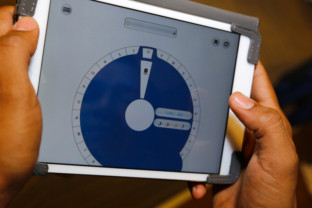
Manama: A mobile application that introduces native English speakers to the Arabic alphabet has been launched by Qatar Foundation International (QFI) and Qatar Computing Research Institute (QCRI) in a new effort to make Arabic more accessible to those unfamiliar with the language.
The mobile application, Madar Al Huruf, uses an interactive and innovatively-designed Arabic language wheel created by Munira Al Badi, a Qatari graphic designer and graduate of Virginia Commonwealth University — Qatar.
Meaning “wheel of letters” in Arabic, Madar Al Huruf is both a physical handheld and virtual wheel. It is user-friendly, designed to be rotatable on two sides and allows non-Arabic speakers to learn how to match English letters and sounds, such as their name, to their Arabic phonetic counterparts.
With QFI support, Munira worked closely with US-based teachers of Arabic in Washington, DC to finalise the wheel’s design. Two Arabic teachers in Tucson, Arizona also assisted in developing the user guide and curriculum.
Originally launched in the US as a physical device, the wheel is being brought to the digital world through the combined efforts of QCRI, QFI and the original designer, in an effort to extend its reach globally to individuals and communities unfamiliar with Arabic.
With QCRI’s expertise in technology around Arabic language research and development, and leveraging the technical advancements that have been made thus far, QFI is now launching the Mobile Application version of Madar Al Huruf.
“Learning the basics of Arabic by writing your name, the name of your hometown or a friend’s name demystifies the language and increases appreciation for the culture in the process,” Maggie Mitchell Salem, Executive Director at Qatar Foundation International, said.
“That is the goal of Madar Al Huruf... We work with talented individuals and partners to break down linguistic and cultural barriers by having those with no prior exposure to Arabic engaging with the alphabet in a fun, interactive and meaningful way.”
QCRI’s Arabic Language Technologies team has been working on a number of projects related to e-education, enabling people to access and learn in a language not native to their own.
“We identified a gap in the online education domain for language learning and have been developing supportive technology for language learning including an assistive language learning tutor and an Arabic e-book reader,” Stephan Vogel, Principal Scientist in the Arabic Language Technologies team at QCRI, said.
“Madar Al Huruf serves as a great first step into a whole host of inventive language learning tools that QCRI has developed for non-native speakers of Arabic.”
Baljit Singh, a graduate of Carnegie Mellon University in Qatar, implemented the iPad and iPhone versions of Madar Al Huruf. Singh was an intern with QCRI during the summer of 2012 and worked on Arabia – a computer assisted language learning application. “I am pleased to see that the skills and techniques which Baljit Singh learned while working on Arabia were applicable to Madar Al Huruf,” Francicso Guzman, Scientist at QCRI and Singh’s mentor, said. “Madar Al Huruf employs a similar intelligent feedback mechanism and multimedia interaction, which benefits those in the process of learning a new language.”
QCRI is one of three national research institutes established by Qatar Foundation, and is part of the Foundation’s Research and Development enterprise.











